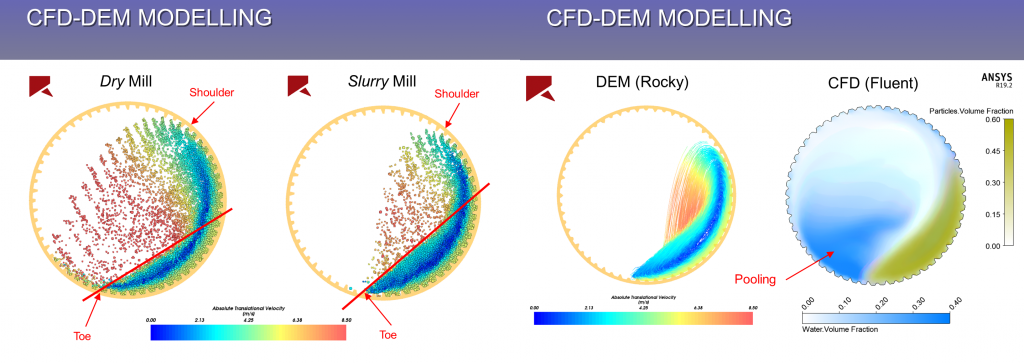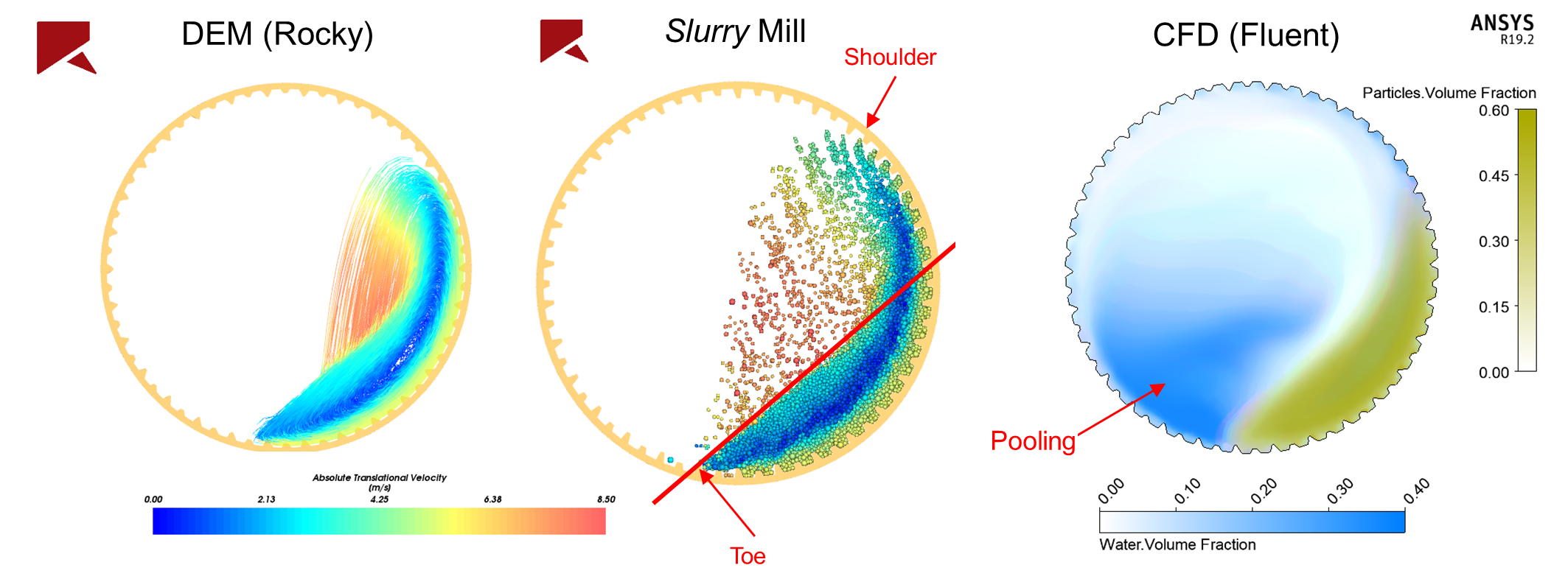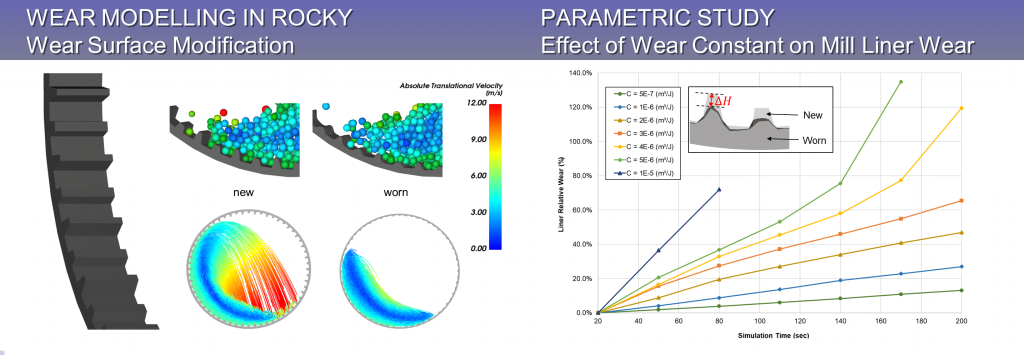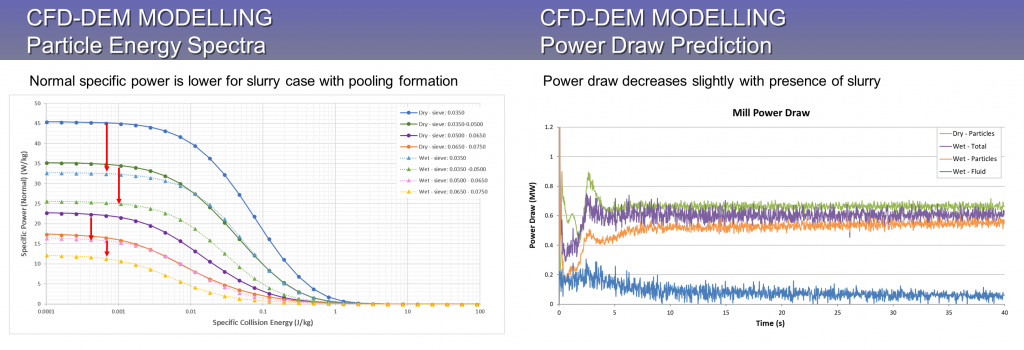Along with ESSS, representatives from LEAP will be in Melbourne today at the 2nd Int'l Symposium on Computational Particle Technology to showcase exciting new modelling work that has been completed recently using Rocky DEM and ANSYS CFD to predict liner wear in a semi-autonomous grinding (SAG) mill. Today's presentation is titled 'Predictive Optimization of SAG Mill WEAR using DEM-CFD' and will be delivered by Dr. Peter Rizkalla from LEAP Australia (Perth office) and here is some background information on this challenging topic:
Semi-Autogenous Grinding (SAG) mills are the technology of choice for reducing primary hard-rock ore to feed size for use in a secondary crusher. In these mills, cascading ore undergoes impact breakage against grinding balls in a rotating cylindrical shell. Continuous operation of these mills is disrupted when the mill liner, comprising lifter bars plates intended to protect the parent shell and provide necessary lift for the grinding action, wears out after months of processing abrasive material. In light of this, it can be a very costly exercise when maintenance intervals, and thus downtime losses, become too frequent. In the mining sector, these losses can be quite substantial. For example, a trained professional crew may require up to 120 hours to replace the worn liner of a SAG mill with each hour costing tens or even hundreds of thousands of dollars, depending on the size of the mill and the plant in which it operates.
Mining companies can realize significant cost savings simply by slowing peak wear rate without compromising throughput, an outcome that calls for optimizing both the liner design and operating process parameters. Likewise, changes to the mill lifter design and/or its operation can result in reduced power draw and therefore energy costs. As SAG and other types of mills are power hungry, even a marginal reduction in power draw can translate to massive energy savings. Conventional approaches to achieve these goals are based on a combination of practical experience and ‘trial-and-error’ studies that modulate design features and/or operating conditions.
However, it is not feasible to perform a comprehensive experimental design, especially when the mill is in constant operation. Discrete element method (DEM) simulations, which are based on first principle physics, have proven very helpful in such cases by enabling increased process insight and evaluation of a large number of possible solutions. Using a commercial DEM software like Rocky, an engineering team can easily evaluate changing process variables, such as speed and fill level, or a new lifter design that incorporates changed face angle and height with a high degree of accuracy.
Today's presentation will highlight how Rocky DEM software (combined with ANSYS CFD as needed for fluidised systems) can help engineers to predict liner wear and fine-tune their design to obtain optimum conditions for SAG mill operation. Contact LEAP today if you have questions on how DEM modelling can help with your process or system!
Who was involved in this work?
Dr. Peter Rizkalla
Peter Rizkalla studied Aerospace Engineering at RMIT and graduated with first-class honors in 2001. He then completed his PhD with Robert Bosch in Germany where developed a numerical model using Computational Fluid Dynamics (CFD) to predict erosion rates of high pressure abrasive slurries in diesel injector nozzles. Peter is currently working at LEAP Australia in WA as Product Manager for their flagship Discrete Element Modelling (DEM) package, Rocky, and is engaged in sales, account management, technical support, training and consulting related activities in both the DEM and CFD lines of business. Since joining LEAP, he has had over 10 years’ experience in providing engineering solutions across a wide range of industries.
Dr. Alex Potapov
Alex obtained his Masters in Geomechanics and PhD in Physics and Mathematics at the Moscow Institute of Physics and Technology. He first joined Conveyor Dynamics Inc (CDI) in 1998 where he spent 3 years there as a project manager. In 2001 he joined Metso Minerals as a Senior Scientist where he developed several CFD and DEM codes. He has a wealth of knowledge and experience in breakage simulations including particle comminution and attrition and has developed several unique programs to simulate size reduction of particles in crushers and grinding mills. After spending almost 10 years at Metso he returned to CDI and started development of Rocky for commercial use. He is currently Chief Technical Officer at ESSS and is leading the core-solver development of Rocky.
Dr. Saurabh Sarkar
Dr. Saurabh Sarkar is an Applications Engineer for the Rocky DEM Business Unit. Prior to joining ESSS, Dr. Sarkar worked as an Adjunct Faculty at Rutgers University and an on-site Consultant at Sunovion Pharmaceuticals where he supported drug formulation and process development activities. He obtained his Ph.D. in Pharmaceutics from the University of Connecticut where his focus was understanding and optimization of different pharmaceutical unit operations using DEM and CFD tools in projects with multiple industrial and government collaborators. He is a Senior Member of the AIChE and serves as an expert reviewer for several journals.








